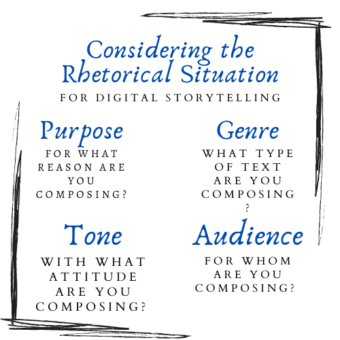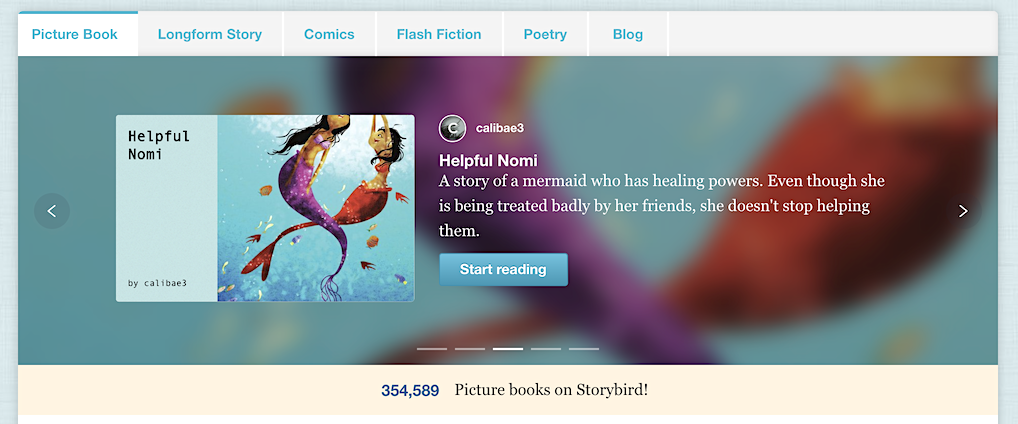Assessing Digital Stories in the Middle Grades
By Katie Caprino and Alyssa Marzili

Katie
When Sam Weigle and I wrote Digital Storytelling: An Exciting Teaching Tool! a few months back, we shared a little bit about what digital storytelling is, why it is a great instructional practice in the middle grades classroom, and some tools that may help your students compose digital stories.

Alyssa
In this follow-up blog post, future teacher Alyssa Marzili and I want to discuss ways you can think about assessing digital stories in your classroom.
We share tips on how engaging middle graders in a consideration of the elements of rhetoric and peer feedback and using digital tools for evaluation can help in the process of assessing students’ digital stories.
Help Students Consider the Writing Situation
One way to think about assigning and assessing student compositions is to think about helping them consider the purpose, genre, context, tone, and audience for which they are writing.
Creating a grid for students at the beginning of the assignment that helps them understand these rhetorical elements may go a long way in helping them create their stories and assess their own pieces.
For example, are students able to articulate their purpose or reason for writing, before, during, and after their digital stories are finished? Are they able to identify the features of the genre? Similarly, what tone, or attitude of the writer, is exemplified within the text? And, finally, who is the audience?
Many student writers, we think, go through much of school not even considering to whom they are writing. The authentic nature of digital stories may help strengthen their audience awareness. Encouraging students to clearly identify for whom they are writing (and preferably, it’s not just you as their teacher) is another step in the right direction.
You can also embed the elements of purpose, genre, context, tone, and audience in your rubric or feedback conversations with students and let them become familiar aspects of the learning experience.
Scaffold the Feedback from Peers
The public nature of digital storytelling makes these stories perfect for peer feedback assessment practices. Asking students to work in ongoing writing groups during the storytelling process can help them gain an audience’s feedback as they write (which is when we believe you should be giving most of your feedback, too).
You and your students can co-construct a list of criteria that can go into a rubric everyone can use to assess the digital stories (including the teacher). One tip we have is to have the writer/composer come up with 2 or 3 open-ended questions they’d like their peers to answer about their pieces. In this way, feedback is student-directed and addresses the specific elements of the writing where composers feel they need input.
Tools like Storybird (https://storybird.com/) that allow sharing with peers help facilitate peer feedback. After exploring many genres including picture books, longform, comics, flash fiction, and poetry, students can select a template (or not) and compose their own digital story. (Click below to enlarge)
When students finish a story, they can share it with peers. Peers can comment on the story, giving the student feedback. Furthermore, this is a great resource because teachers can also have students focus on a certain skill set and see the progress the student is making. This progress can help you when conducting writing conferences with your digital writers.
Invite Digital Tools into the Assessment Process
Digital storytelling relies on digital tools, so it makes sense to use them in the assessment process. Instead of a final written reflection, have students use tools such as Animoto or Vocaroo to share how they developed as writers, how they developed as digital writers, and what future writing goals they have.
You can also use similar digital tools to offer feedback on a particular student’s piece – or to create whole-class feedback, feedback that is not student-specific but rather provides insights to a group of students that they can use in their final drafts or future writing assignments.
Please feel free to share your digital story assessment successes with us! We’d love for you to reach out!
The authors appreciate funding from the Mellon Foundation.
Katie Caprino is an Assistant Professor of PK-12 New Literacies at Elizabethtown College in Pennsylvania. She taught middle and high school English in Virginia and North Carolina. She holds a BA from the University of Virginia, a MA from the College of William and Mary, a MA from Old Dominion University, and a Ph.D. from the University of North Carolina at Chapel Hill.
Katie researches and presents on children’s, middle grades, and young adult literature; the teaching of writing; and incorporating technology into the literacy classroom. You can follow her on Twitter at @KCapLiteracy and visit her book blog at katiereviewsbooks.wordpress.com.
Alyssa Marzili is a senior Early Childhood Education major at Elizabethtown College with a minor in English Professional Writing. Presently, she is the Editor-in-Chief of The Etownian and the lead writing tutor. In her free time, she writes fictional books, mostly middle-level and young adult.




































